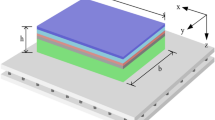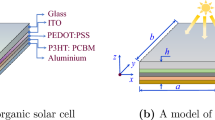Abstract
In this study, analytical solutions for the static buckling and vibration analysis of nanocomposite multilayer perovskite solar cell (NMPSC) on elastic foundations are presented. The NMPSC consists of six isotropic layers which are including Au, PEDOT:PSS, perovskite, PCBM, ITO and glass. The basic equations are derived based on the Reddy’s higher order shear deformation plate theory with the consideration of Pasternak-type elastic foundations interaction, von-Kármán strain terms, initial imperfection and damping. The NMPSC is subjected to the uniformly distributed external pressure, axial compressive load and exposed to uniform temperature rise. The relationship between deflection amplitude and time, axial compressive loading and deflection amplitude, the frequency ratio and amplitude as well as the expressions of the natural frequency and critical buckling load are obtained by using Galerkin and Runge–Kutta methods. Bees Algorithm is used to maximize the natural frequency and critical buckling load of the NMPSC depending on ten geometrical and material parameters. The effects of temperature increment, elastic foundations, initial imperfection and geometrical parameters on the static buckling and vibration characteristics of the NMPSC are discussed through the parametric studies.













Similar content being viewed by others
References
Kurukavak, K.Ç., Yılmaz, T., Büyükbekar, A., Kuş, M.: Effect of different terminal groups of phenyl boronic acid self-assembled monolayers on the photovoltaic performance of organic solar cells. Opt. Mater. (Amst.) 112, 110783 (2021). https://doi.org/10.1016/j.optmat.2020.110783
Rana, D., Materny, A.: Effect of static external electric field on bulk and interfaces in organic solar cell systems: a density-functional-theory-based study. Spectrochim. Acta Part A Mol. Biomol. Spectrosc. 253, 119565 (2021). https://doi.org/10.1016/j.saa.2021.119565
Huang, T., Bai, Y., Wang, J., Wang, F., Dai, M., Han, F., Du, S.: Optimizing binding energy and electron-hole pair binding distance for efficient organic solar cells with low voltage loss. Sol. Energy 230, 628–634 (2021). https://doi.org/10.1016/j.solener.2021.10.002
Li, Q., Wang, Q., Wu, D., Chen, X., Yu, Y., Gao, W.: Geometrically nonlinear dynamic analysis of organic solar cell resting on Winkler–Pasternak elastic foundation under thermal environment. Compos. Part B Eng. 163, 121–129 (2019). https://doi.org/10.1016/j.compositesb.2018.11.022
Li, Q., Wu, D., Gao, W., Tin-Loi, F.: Size-dependent instability of organic solar cell resting on Winkler–Pasternak elastic foundation based on the modified strain gradient theory. Int. J. Mech. Sci. 177, 105306 (2020). https://doi.org/10.1016/j.ijmecsci.2019.105306
Keskin, A.V., Gençten, M., Bozar, S., Arvas, M.B., Güneş, S., Sahin, Y.: Preparation of anatase form of TiO2 thin film at room temperature by electrochemical method as an alternative electron transport layer for inverted type organic solar cells. Thin Solid Films 706, 138093 (2020). https://doi.org/10.1016/j.tsf.2020.138093
Chaudhary, D.K., Dhawan, P.K., Patel, S.P., Bhasker, H.P.: Large area semitransparent inverted organic solar cells with enhanced operational stability using TiO2 electron transport layer for building integrated photovoltaic devices. Mater. Lett. 283, 128725 (2021). https://doi.org/10.1016/j.matlet.2020.128725
Kaçuş, H., Baltakesmez, A., Çaldıran, Z., Aydoğan, Ş, Yılmaz, M., Sevim, M.: Optical and electrical characterization of organic solar cells obtained using gold and silver metal nanoparticles. Mater. Today Proc. 46, 6986–6990 (2021). https://doi.org/10.1016/j.matpr.2021.03.276
Dat, N.D., Anh, V.M., Quan, T.Q., Pham, T.D., Duc, N.D.: Nonlinear stability and optimization of thin nanocomposite multilayer organic solar cell using Bees Algorithm. Thin-Walled Struct. 149, 106520 (2021). https://doi.org/10.1016/j.tws.2019.106520
Shin, D.H., Jang, C.W., Ko, J.S., Choi, S.H.: Enhancement of efficiency and stability in organic solar cells by employing MoS2 transport layer, graphene electrode, and graphene quantum dots-added active layer. Appl. Surf. Sci. 538, 148155 (2021). https://doi.org/10.1016/j.apsusc.2020.148155
Raman, R.K., Gurusamy Thangavelu, S.A., Venkataraj, S., Krishnamoorthy, A.: Materials, methods and strategies for encapsulation of perovskite solar cells: from past to present. Renew. Sustain. Energy Rev. 151, 111608 (2021). https://doi.org/10.1016/j.rser.2021.111608
Girish, K.H.: Advances in surface passivation of perovskites using organic halide salts for efficient and stable solar cells. Surf. Interfaces 26, 101420 (2021). https://doi.org/10.1016/j.surfin.2021.101420
Guo, Z., Lin, B.: Machine learning stability and band gap of lead-free halide double perovskite materials for perovskite solar cells. Sol. Energy 228, 689–699 (2021). https://doi.org/10.1016/j.solener.2021.09.030
Wang, S., Cao, F., Wu, Y., Zhang, X., Zou, J., Lan, Z., et al.: Multifunctional 2D perovskite capping layer using cyclohexylmethylammonium bromide for highly efficient and stable perovskite solar cells. Mater. Today Phys. 21, 100543 (2021). https://doi.org/10.1016/j.mtphys.2021.100543
Zhang, Y., Xu, L., Wu, Y., Zhou, Q., Shi, Z., Zhuang, X., et al.: Double-layer synergistic optimization by functional black phosphorus quantum dots for high-efficiency and stable planar perovskite solar cells. Nano Energy 90, 106610 (2021). https://doi.org/10.1016/j.nanoen.2021.106610
Huang, Z.L., Chen, C.M., Lin, Z.K., Yang, S.H.: Efficiency enhancement of regular-type perovskite solar cells based on Al-doped ZnO nanorods as electron transporting layers. Superlattices Microstruct. 102, 94–102 (2017). https://doi.org/10.1016/j.spmi.2016.12.012
Li, Q., Tian, Y., Wu, D., Gao, W., Yu, Y., Chen, X., Yang, C.: The nonlinear dynamic buckling behaviour of imperfect solar cells subjected to impact load. Thin-Walled Struct. 169, 108317 (2021). https://doi.org/10.1016/j.tws.2021.108317
Cho, S., Lee, H., Seo, Y., Na, S.: Multifunctional passivation agents for improving efficiency and stability of perovskite solar cells: synergy of methyl and carbonyl groups. Appl. Surf. Sci. 575, 151740 (2022). https://doi.org/10.1016/j.apsusc.2021.151740
Varghese, A.S., Panda, S.: Stability analysis on the flow of thin second-grade fluid over a heated inclined plate with variable fluid properties. Int. J. Non Linear Mech. 133, 103711 (2021). https://doi.org/10.1016/j.ijnonlinmec.2021.103711
Noroozi, A.R., Malekzadeh, P., Dimitri, R., Tornabene, F.: Meshfree radial point interpolation method for the vibration and buckling analysis of FG-GPLRC perforated plates under an in-plane loading. Eng. Struct. 221, 111000 (2020). https://doi.org/10.1016/j.engstruct.2020.111000
Moradi-Dastjerdi, R., Behdinan, K.: Stability analysis of multifunctional smart sandwich plates with graphene nanocomposite and porous layers. Int. J. Mech. Sci. 167, 105283 (2020). https://doi.org/10.1016/j.ijmecsci.2019.105283
Shen, H.S., Xiang, Y., Fan, Y.: A novel technique for nonlinear dynamic instability analysis of FG-GRC laminated plates. Thin-Walled Struct. 139, 389–397 (2019). https://doi.org/10.1016/j.tws.2019.03.010
Stojanović, V., Petković, M.D., Deng, J.: Stability of parametric vibrations of an isolated symmetric cross-ply laminated plate. Compos. Part B Eng. 167, 631–642 (2019). https://doi.org/10.1016/j.compositesb.2019.02.041
Kolahchi, R., Kolahdouzan, F.: A numerical method for magneto-hygro-thermal dynamic stability analysis of defective quadrilateral graphene sheets using higher order nonlocal strain gradient theory with different movable boundary conditions. Appl. Math. Model. 91, 458–475 (2021). https://doi.org/10.1016/j.apm.2020.09.060
Tubaldi, E., Alijani, F., Amabili, M.: Non-linear vibrations and stability of a periodically supported rectangular plate in axial flow. Int. J. Non Linear Mech. 66, 54–65 (2014). https://doi.org/10.1016/j.ijnonlinmec.2013.12.004
Duc, N.D., Lam, P.T., Quan, T.Q., Quang, P.M., Quyen, N.V.: Nonlinear post-buckling and vibration of 2D penta-graphene composite plates. Acta Mech. 231, 539–559 (2020). https://doi.org/10.1007/s00707-019-02546-0
Sofiyev, A.H.: On the solution of the dynamic stability of heterogeneous orthotropic visco-elastic cylindrical shells. Compos. Struct. 206, 124–130 (2018). https://doi.org/10.1016/j.compstruct.2018.08.027
Namvar, A.R., Vosoughi, A.R.: Design optimization of moderately thick hexagonal honeycomb sandwich plate with modified multi-objective particle swarm optimization by genetic algorithm (MOPSOGA). Compos. Struct. 252, 112626 (2020). https://doi.org/10.1016/j.compstruct.2020.112626
Innami, M., Honda, S., Sasaki, K., Narita, Y.: Analysis and optimization for vibration of laminated rectangular plates with blended layers. Compos. Struct. 274, 114400 (2021). https://doi.org/10.1016/j.compstruct.2021.114400
Tu, T.M., Anh, P.H., Loi, N.V., Tuan, T.A.: Optimization of stiffeners for maximum fundamental frequency of cross-ply laminated cylindrical panels using social group optimization and smeared stiffener method. Thin-Walled Struct. 120, 172–179 (2017). https://doi.org/10.1016/j.tws.2017.08.033
Anh, V.M., Quan, T.Q., Tran, P.: Nonlinear vibration and geometric optimization of nanocomposite multilayer organic solar cell under wind loading. Thin-Walled Struct. 158, 107199 (2021). https://doi.org/10.1016/j.tws.2020.107199
Jing, Z., Sun, Q., Zhang, Y., Liang, K.: Buckling optimization of composite rectangular plates by sequential permutation search with bending-twisting correction. Appl. Math. Model. 100, 751–779 (2021). https://doi.org/10.1016/j.apm.2021.07.031
Pham, T.D., Castellani, M.: The Bees Algorithm: modelling foraging behavior to solve continuous optimization problems. Proc. Inst. Mech. Eng. Part C J. Mech. Eng. Sci. 223, 2919–2938 (2009). https://doi.org/10.1243/09544062JMES1494
Brush, D.D., Almroth, B.O.: Buckling of Bars, Plates and Shells. Mc. Graw-Hill, New York (1975)
Reddy, J.N.: Mechanics of Laminated Composite Plates and Shells: Theory and Analysis. CRC Press, Boca Raton (2004)
Author information
Authors and Affiliations
Corresponding author
Ethics declarations
Conflict of interest
The authors declare that they have no conflict of interest.
Additional information
Publisher's Note
Springer Nature remains neutral with regard to jurisdictional claims in published maps and institutional affiliations.
Appendices
Appendix A
Appendix B
Appendix C
Rights and permissions
Springer Nature or its licensor (e.g. a society or other partner) holds exclusive rights to this article under a publishing agreement with the author(s) or other rightsholder(s); author self-archiving of the accepted manuscript version of this article is solely governed by the terms of such publishing agreement and applicable law.
About this article
Cite this article
Quan, T.Q., Dat, N.D. & Duc, N.D. Static buckling, vibration analysis and optimization of nanocomposite multilayer perovskite solar cell. Acta Mech 234, 3893–3915 (2023). https://doi.org/10.1007/s00707-023-03588-1
Received:
Accepted:
Published:
Issue Date:
DOI: https://doi.org/10.1007/s00707-023-03588-1




